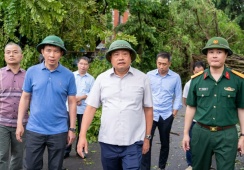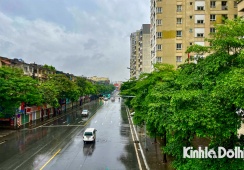
Chairman of the Hanoi People’s Committee Tran Sy Thanh on the night of September signed an urgent directive to address potential flooding on the city’s rivers as consequences of typhoon Yagi or Storm No. 3.
| Rising water level at Long Bien Bridge, Hanoi on the morning of September 10. Photo: Ngo Minh/The Hanoi Times |
The directive calls for all relevant departments and leaders to proactively prepare flood prevention plans, ensuring safety for residents, particularly in high-risk areas near rivers, low-lying regions, and areas prone to flash floods.
Key actions include: (1) Public awareness and safety measures, (2) 24/7 Monitoring and response teams, (3) Evacuation plans, (4) Infrastructure and environmental safety, (5) Support for economic sectors, (6) Utilities and public services, (7) and Health and social support.
The immediate notification to residents and organizations in flood-prone areas is keeping vigilance on safety measures, with increased communication through schools, communities, and organizations to ensure people are aware of the risks.
Response forces are available all day night to ensure continuous monitoring of weather conditions, maintaining communication lines, and coordinating timely rescue efforts. Forces are to be on standby for quick deployment if needed.
Meanwhile, it’s necessary to identify dangerous zones and prepare for the evacuation of people and assets to safe locations. Lists of households needing relocation are to be created, with secure shelters ready to provide food, water, and medical supplies.
Additionally, it requires efforts to inspect and reinforce dykes, bridges, and other critical structures, and manage flood-prone transportation routes to ensure safety.
The directive highlighted the need to ensure the safety of ongoing construction projects and waterway transportation, prepare flood protection for agricultural activities, and secure fish farming and production areas.
At the same time, it keeps regular checks on electricity and communication systems to avoid outages and ensure prompt restoration of services in affected areas.
The last but not least, relevant agencies are tasked to ensure coordinated medical services to prevent disease outbreaks and ensure the health and safety of vulnerable groups, such as children, the elderly, and people with disabilities.
All departments are required to closely monitor flood situations, coordinate effectively, and report any emergencies to ensure swift responses to protect the population and property.



